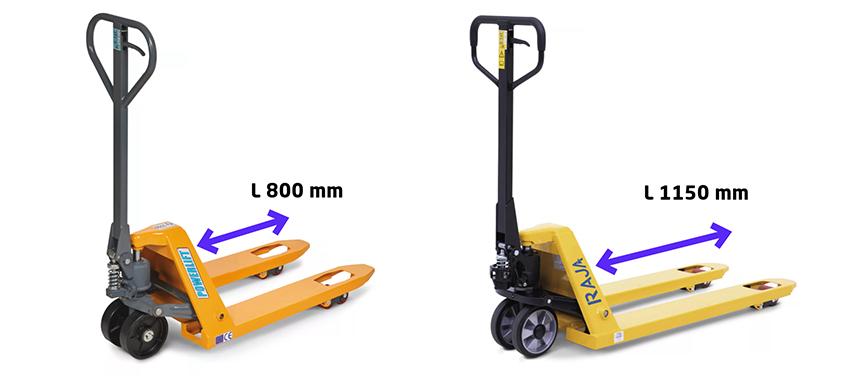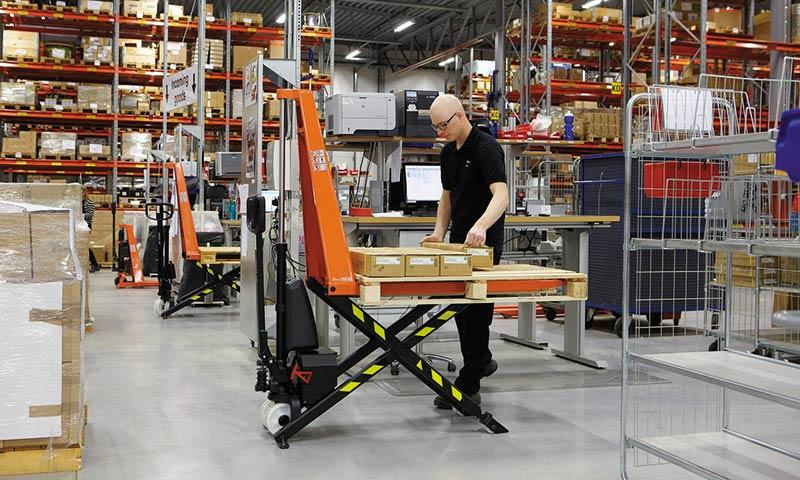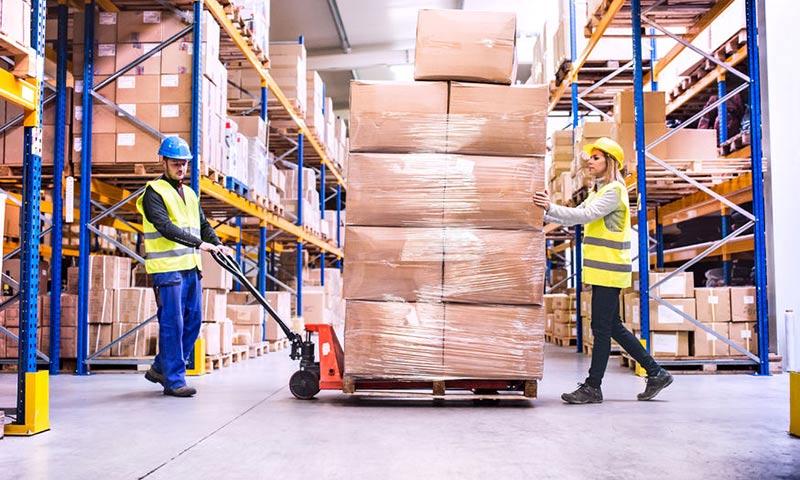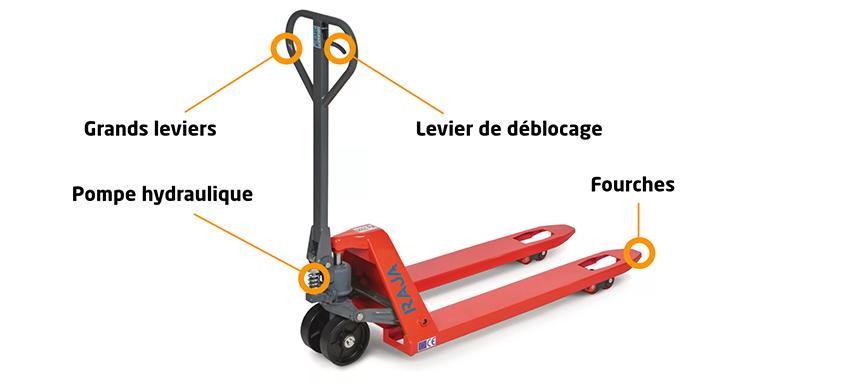Palletising and pallet handling are key processes in the warehouse. Not only do they affect the protection of your goods, but also the rate at which they are dispatched, and above all the health of your teams. The way in which goods are moved has a significant impact on the health of logistics staff. According to international standards, manual lifting of loads in excess of 25 kg is not recommended. Do you need to move a heavy stack of goods on a pallet? Then a pallet truck is the best solution.
So what is the ideal pallet truck for your type of warehouse, your logistics operations or the needs of your staff? These are the key questions to ask when choosing a new pallet truck. By doing so, you’ll increase the productivity of your teams, improve the ergonomics of your workplace and speed up logistics processes.
1. In what environment do you intend to use the pallet truck?
Before even looking at the different models of pallet truck, you need to ask yourself a crucial question: in what environment will your operators be using the machine? The answer to this question will determine the materials from which the ideal pallet truck should be made. You work in :
- An environment with specific hygiene protocols (pharmaceutical, food, etc.)? Opt for a plastic pallet truck, which can easily be brought up to the necessary hygiene standards .
- A damp or corrosive environment (food processing, port areas, chemical industries, etc.)? Consider a stainless steel pallet truck, which will withstand contact with moisture and chemicals over time.
- A relatively standard indoor environment? A galvanised steel pallet truck should suffice.
The second important factor when it comes to the environment in which the machine will be used is the nature of the ground. This will determine the type of pallet truck wheels.
- Rubber wheels are quiet and provide good grip on industrial and slippery surfaces .
- Polyurethane wheels do not soil floors, and are particularly recommended for sensitive floors that are more flexible in use.
2. What goods do you need to transport?
To choose the right pallet truck for your needs, you also need to think about the type of goods you need to handle. The size of the pallets to be transported will be crucial to making an informed choice:
- For small pallets, choose a pallet truck with short forks (800 mm).
- For ordinarypallets , opt for a standard fork model (1150 mm).
- For long pallets, choose a pallet truck with long forks (1800 mm).
You should also find out the maximum load your pallet truck can handle. At RAJA, we offer models with a payload of up to 2,500 kg. However, if you need to handle a higher load, you’ll need to make sure you find the right machine for the job.

3. What height of lift would you like?
The lift height of the pallet truck is a decisive factor to take into account in your warehouse. A machine that lifts goods at the ideal height will save your operators unnecessary effort, and reduce the risk of Musculoskeletal Disorders (MSD) in the warehouse. A standard-lift pallet truck will be able to lift goods to a height of around 20 cm.
However, you may need more lifting height. If this is the case, make sure you choose a high-lift pallet truck (electric or manual): some can go up to 800 mm above the ground.

4. Which pallet truck to ensure operator safety?
Because the use of load-carrying equipment is never trivial, it is absolutely essential to take an interest in the safety of operators. When making this choice, consider whether the pallet truck is equipped with :
- A safety valve, to indicate any overload,
- A multi-position tiller arm (for manual pallet trucks), to adapt the machine’s inclination to that of the ground when moving.

5. Manual or electric pallet truck?
The question is worth asking: does your logistics business need a manual or electric pallet truck? As you know, the advantage of the latter is that it makes handling easier, thanks to a motorised system. This allows the operator to maintain an upright posture, reducing the risk of Musculoskeletal Disorders (MSD) associated with handling.
Manual pallet trucks (also known as ‘pallet pullers’) are much cheaper, but only have a hydraulic pump, which does little to reduce the effort required of the operator.
- The cost of an electric pallet truck can start from €1,500, while €300 is enough to buy a good-quality manual pallet truck.
- In addition to the purchase price, you’ll need to think about the costs of maintenance, servicing and warranty. Note that parts for repairing a manual pallet truck are easier to find and less expensive.
- If you choose an electric pallet truck, you’ll need to think about training your pallet-handling operators. This will involve training costs and downtime for your teams.
In short, there is a significant cost involved in combating RSI and arduous work in the warehouse, and this should be taken into account when choosing the right handling equipment available on the market.
Pallet truck, stacker or forklift?
One last question before making the final choice: should you consider buying a pallet truck, a stacker or a forklift? The difference between these machines is worth noting.
The pallet truck is the simplest equipment in terms of design and use. It’s easy to use and doesn’t require much maintenance. It is mainly used to move (palletised) goods that are low to the ground. This is the preferred entry-level model for most types of warehouse.
For its part, a stacker, as its name suggests, is dedicated to stacked goods (i.e. those that need to be lifted, then stacked and/or stored high). A stacker can lift pallets up to 5 m high. It will cost more than a pallet truck.
Lastly, a forklift truck is best suited to warehouses with intense workloads, long-distance transport and very heavy loads (up to 8 tonnes). It can lift loads up to 8 metres high. However, it is very expensive to buy, with entry-level prices approaching €6,000.

How to: how to use a pallet truck correctly?
Have you chosen the pallet truck that meets your needs? Great! Here are some more tips that will help you when using your pallet truck.
- You can push as well as pull a pallet truck. As most people can push more weight than they pull, it is always safer for the user to push.
- Before using your pallet truck, always check the bodywork and the quality of the wheels. They must not be damaged. It’s also a good idea to check the maximum load. This is usually indicated on the appliance itself .
- Use the release lever (usually near the handles) to release the hydraulic fluid. This allows the forks to lower to the ground. Then slide the forks under your load (pallet).
- Are the forks correctly positioned under the load? If so, you can pump by pulling the large levers towards you several times. The pressure of the hydraulic fluid then increases, which has the effect of raising the lifting forks. This should enable you to push and move the pallet truck easily.















